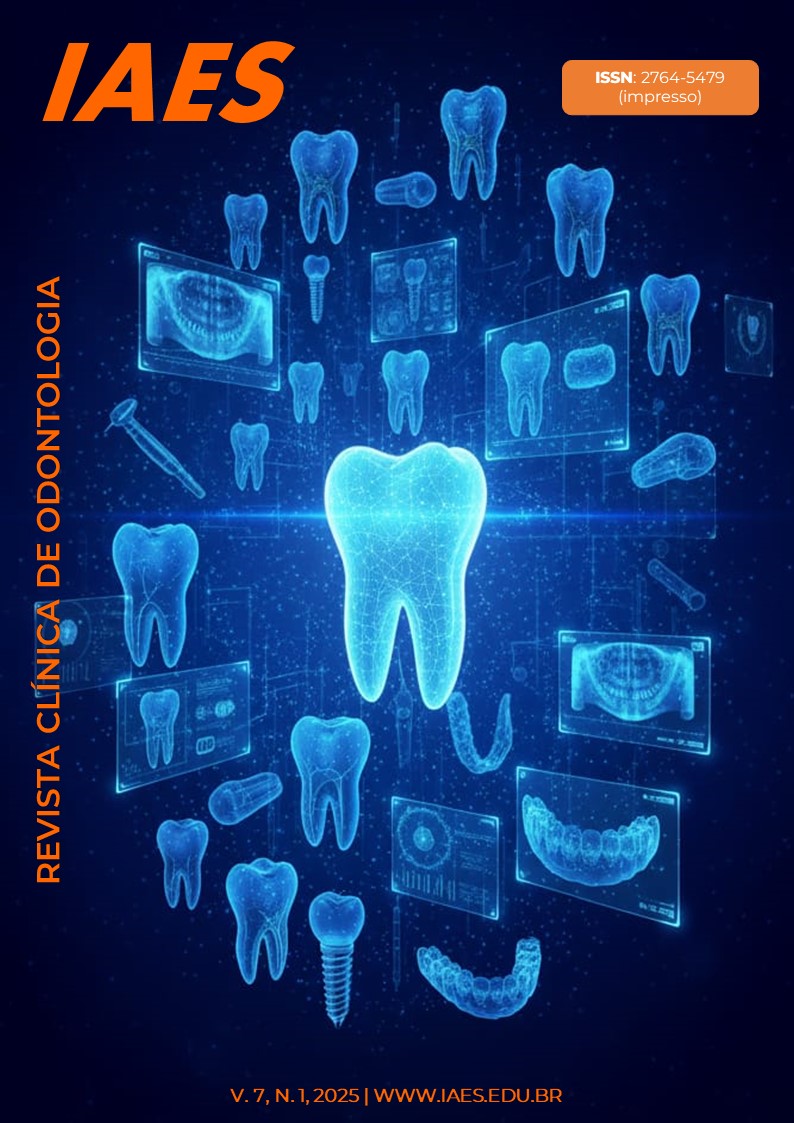Single-session endodontic retreatment of a birooted tooth with intraoral fistula: case report
DOI:
https://doi.org/10.70614/jvjm8370Keywords:
Endodontics, Retreatment, Fistula, DentistryAbstract
Endodontic retreatment is a procedure performed on a previously treated tooth, which for some reason was unsuccessful, presenting clinical and/or radiographic repercussions and which can be performed in a single session when well indicated. One of the signs that there has been an irregularity is the presence of an intraoral fistula, which suggests persistence or recurrence of an infection in the periapical tissue. The objective of this work was to present a clinical case of endodontic retreatment in a birooted tooth with intraoral fistula, in which the patient T.M.B.C, female, attended the Clínica Escola de Postgraduate em Odontologia da Faculdade do Amazonas (IAES) with a main complaint of “a little ball on top of the tooth” that had lasted 3 to 4 weeks. Radiographic examinations and fistulography were performed to identify the origin of the infection. The system of choice for retreatment was PRO T from MK Life, with the aid of the Motor Easy Bassi iRoot® endodontic motor and Finepex Schuster® apical locator using the instrumentation sequence S2, F1, F2 and F3 (Pro T – MK Life), alternating with hand files type K #10 and #15 (Dentsply®) with the working length of the canals being buccal 19 mm and palatal 18 mm, with 2.5% sodium hypochlorite irrigation (Asfer – Brazil) and aspiration. It is concluded that the technique used was effective as it promoted the preservation of the affected tooth, contributing significantly to improving the patient's quality of life.
Downloads
References
1. Kaled GH, et al. Retratamento endodôntico: análise comparativa da efetividade da remoção da obturação dos canais radiculares realizada por três métodos. Rev. Gaúcha Odontol. 2011; 59(1):103-8
2. Estrela C. Endodontia laboratorial e clínica. 1. ed. São Paulo: Artes Médicas; 2013.
3. Al Khasawnah Q, et al. Nonsurgical clinical management of periapical lesions using calcium hydroxide-iodoform silicon-oil paste. Biomed Res Int. 2018;1-8.
4. Hori GMR, et al. Sucesso após retratamento endodôntico: importância da limpeza e desinfecção do sistema de canais radiculares. Arch Health Invest. 2021;10(8):1212-1216.
5. Figini L, et al. Single versus multiple visits for endodontic treatment of permanent teeth: a Cochrane systematic review. J Endod. 2008;34(9):1041-7.
6. Endo MS, et al. Endodontia em sessão única ou múltipla: revisão da literatura. RFO. 2015;20(3):408-13.
7. Frigini Martinelli PC, et al. Retratamento endodôntico utilizando PUI e PDT em sessão única: relato de caso clínico. Rev Saber Digital. 2019;12(1):113–121.
8. Ricucci D, et al. Pulp Response to Periodontal Disease: Novel Observations Help Clarify the Processes of Tissue Breakdown and Infection. J Endod. 2021;47(5):740-754.
9. Gonçalves GSY, et al. Tratar ou extrair? Tratamento de lesão endoperiodontal, um relato de caso clínico. 2020.
10. Lopes HP, Siqueira JF. Endodontia: biologia e técnica. Rio de Janeiro: Medsi-Guanabara Koogan; 2015.
11. Rotstein I, Simon JH. Diagnosis, prognosis, and decision-making in the treatment of combined periodontal-endodontic lesions. J Periodontol. 2004;34:165-203.
12. Macedo S, et al. Fístula intraoral de origem dentária: a propósito de um caso clínico. Cad Saúde. 2013;6, Medicina Dentária.
13. Melo SL, et al. Tratamento endodôntico com presença de fístula: revisão de literatura. Rev Cathed. 2022;4(1).
14. Grossman LI, Oliet S, Del Rio CE. Endodontic practice. Lea & Febiger; 2016.
15. Ng Y-L, Mann V, Rahbaran S. Outcome of primary root canal treatment: systematic review of the literature - part 2. influence of clinical factors. Int Endod J. 2019;43(4):309–323.
16. Gutmann JL. Manual of endodontics. 2th. Blackwell Munksgaard; 2002.
17. Siqueira Jr. JF. Endodontia: biologia e técnica. Rio de Janeiro: Elsevier; 2016.
18. Leonardo MR, Leonardo RT. Tratamento das fístulas radiculares e suas complicações. In: Leonardo MR, Leonardo RT, eds. Endodontia: tratamento de canais radiculares. 4th ed. São Paulo: Santos; 2018. p. 411-418.
19. Johnson BR, Ruddle CJ. Micro-endodontics. In: Hargreaves KM, Berman LH, eds. Cohen’s pathways of the pulp. 11th ed. Mosby Elsevier; 2015. p. 289-340.
20. Smith JG, Cunningham CJ. Radiographic imaging for the dental team. 5th ed. Elsevier; 2018.
21. Silva EJNL, et al. Current trends and future perspectives of dental root canal treatment using advanced regenerative endodontic techniques. Int J Mol Sci. 2019;20(2):364.
22. Tavares PB, et al. Influence of the apical enlargement size on the endotoxin level reduction of dental root canals. Braz Dent J. 2017;28(3):301–305.
23. Peters OA, Barbosa-Ribeiro M. Micro-CT in endodontic research: A systematic review. Int Endod J. 2017;50(8):773–788.
24. Smith AJ, Matthews JB. Technique-sensitive endodontics. in: hargreaves km, berman lh, eds. cohen’s pathways of the pulp. 12th ed. Mosby Elsevier; 2019. p. 858-910.
25. Gutmann JL, Harrison JW, Gutmann MS. Introdução à endodontia: princípios e práticas. Artmed Editora; 2016.
26. Siqueira Jr. JF. Endodontia: biologia e técnica. Elsevier Editora; 2017.
27. Tsesis I, et al. Outcomes of surgical endodontic treatment performed by a modern technique: An updated meta-analysis of the literature. J Endod. 2017;43(7):1163–1169.
Downloads
Published
Issue
Section
License
Copyright (c) 2025 Revista Clínica de Odontologia

This work is licensed under a Creative Commons Attribution 4.0 International License.






